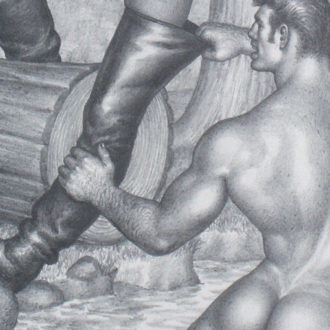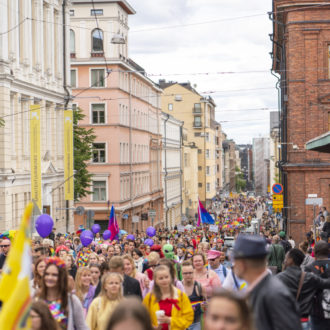New York’s Museum of Modern Art owns a number of Tom of Finland’s works, and the museums that have shown his drawings range from the Museum of Contemporary Art in Los Angeles to the Institute of Contemporary Art in London.
Born Touko Laaksonen near the southwestern Finnish city of Turku, he received the nickname Tom of Finland in the late 1950s from Bob Mizer, the editor of the magazine Physique Pictoral, which published Laaksonen’s homoerotic drawings.
Advocating for tolerance

This Tom of Finland stamp is one of a 2014 set of three that became the best-selling set ever released by the Finnish Postal Service.Photo: Finnish Postal Service/Lehtikuva
His hypermasculine characters became a significant part of gay culture, affecting the way homosexuals were perceived and how they perceived themselves. His work remains relevant, and still has a significant role in the way sexual minorities perceive themselves.
Through his art, he contributed to advancing human rights and advocating for tolerance, respect and freedom. This continues to be his legacy, and it lives on in the Tom of Finland Foundation, which maintains his former house in Los Angeles as a museum, library, event centre and artist residence. One of the foundation’s goals is “preserving erotic art and educating the general public as to its importance,” says founder Durk Dehner on the organisation’s website.
Tom of Finland grew up and lived much of his time in an environment where homosexuality was illegal (in Finland, it did not become decriminalised until 1971). His life has been the subject of a movie and a musical; both premiered in 2017. There’s even a Tom of Finland emoji.
The Finnish Postal Service’s most popular set of stamps ever is the one featuring Tom of Finland’s drawings, and Finnish textile manufacturer Finlayson has had great success with sheets, pillowcases, bags, socks, reflectors, towels and potholders based on Tom of Finland’s art.
Read more about the artist in an earlier ThisisFINLAND article. The Suomi-Finland Podcast released a special edition in 2020 for Tom of Finland’s 100th birthday:
Acceptance on the agendaThe International Day against Homophobia, Transphobia and Biphobia, founded in 2004, is held annually on May 17. It aims to raise awareness about the discrimination and repression that affects LGBTQI+ communities all over the world. The organisers hope that it will attract “the attention of decision-makers, the media, the public, corporations, opinion leaders and local authorities” so that progress can be made. Different organisations mark the day in different ways. “Everyone is free to communicate as they wish.” Thousands of May 17 events, initiatives and celebrations take place in more than 130 countries, including 37 countries where same-sex acts are still illegal. |
By ThisisFINLAND staff, May 2020, updated May 2022







